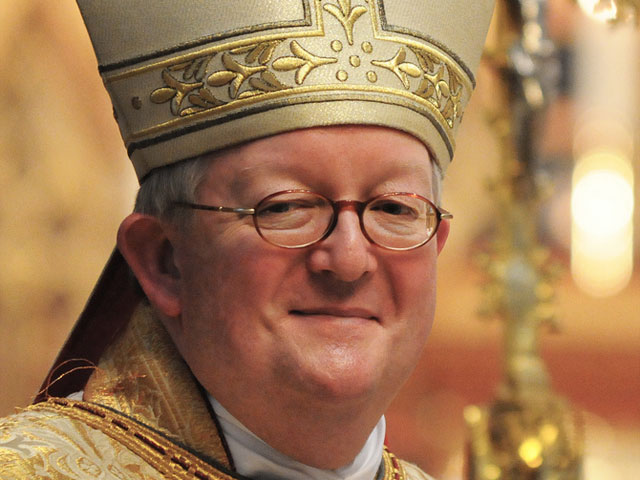Media outlets had a lot of fun with a recent story about a Vatican gatecrasher. A sample of the headlines include Time: Fake Bishop Tries to Sneak into Vatican Meeting; Vanity Fair: Theological Espionage! Fake Bishop Sneaks Into Vatican; NPR: At The Vatican, ‘No Rush’ To Set Conclave; And A Fake Bishop Tries To Get In; Daily Beast: Fake Bishop Sneaks Into Vatican; San Francisco Chronicle: Vatican not amused by fake bishop who posed with cardinals; and CNN: Fake bishop busted and booted from Vatican.
That story begins:
Move over, Tareq and Michaele Salahi, the Virginia ex-couple who famously – or infamously – crashed President Obama’s first White House state dinner. There’s a new impostor posing with dignitaries, and he set his sights on an even more coveted gathering.
Meet Ralph Napierski, a German self-declared bishop who reportedly called himself “Basilius,” said he was with the nonexistent “Italian Orthodox Church” and set out to infiltrate a Monday meeting of cardinals at the Vatican.
The fake bishop donned a purple sash (really a scarf) over his vestments and mingled with cardinals and others who’d flown in from around the globe ahead of the conclave to pick a new pope. He smiled wide and posed for cameras while shaking hands with Cardinal Sergio Sebiastiana. He tried to blend in.
And here’s ABC News: Prankster Nearly Sneaks Into Meeting of Cardinals
The Swiss Guard promptly ejected the man, later identified as Ralph Napiersi, who told reporters his name was “Basilius.” Napierski said he belonged to an Italian Orthodox Church, which does not exist.
A website that appears to be associated with him describes him as a bishop of Corpus Dei, a fictional Catholic group. The site not only has a fanciful coat of arms for the fake bishop – the motto “Horse of Christ” – it traces his phony credentials all the way back to an 18th Century Patriarch of Babylon.
Napierski is a proponent of “Jesus Yoga” and claims to be a keeper of relics, items of religious veneration because they were touched by or belonged to a saint.
“We want to equip churches (especialy [sic] those with low income) with high class relics,” it says on his website. There are lots of spelling mistakes on the site.
Now what’s fascinating to me about the media coverage of this situation is how it is 180 degrees different from the coverage we see of Roman Catholic WomenPriests! In those stories, there is no such language mocking the individuals claiming to be Catholic priests or the group they’re aligned with. There’s no real questioning of the claim to being genuinely Catholic in at least some sense.
But, as could be said about many extreme positions, this coverage goes way too far in the opposite direction. To understand how and why, I’d recommend reading through Orthodox pastor Andrew Damick’s post “Media Discovers Episcopus Vagans at Vatican, Film at 11.”
From Wikipedia:
Episcopi vagantes (singular: episcopus vagans, Latin for wandering bishops or stray bishops) are persons who have been consecrated as Christian bishops outside the structures and canon law of the established churches, and who are not in communion with any generally recognized diocese. Also included are those who have in communion with them small groups that appear to exist solely for the bishop’s sake.[1] Those described as wandering bishops often see the term as pejorative.
Damick notes that while the Roman Catholic Church may consider this man to be a fake bishop or a prankster with a fictional Catholic group, that might not be the only view. And while Napierski is described as self-appointed, he at least claims to have been ordained by others. There’s more:
Of course, there’s actually a chance that the Vatican might regard his episcopal ordination as “valid” (though unlawful), if it can be shown that his episcopal succession is “valid” in all its propers. Roman Catholic theology of ordination regards it as an “indelible mark” that continues even in heresy, apostasy and schism, so there may be “valid” bishops outside the actual communion of the Roman Catholic Church. (This is how Rome can regard Orthodoxy as “valid” even though it doesn’t submit itself to the pope.) Orthodoxy, by contrast, regards ordination as existing only within the ecclesial community.
Those who have done some study of episcopi vagantes would recognize all the marks here of such a man’s presence online—the prominent display of the claim to apostolic succession, the badly-fitting and not-quite-right clerical garb, the confusing and misspelled website, the attempts to associate one’s ecclesiastical associates with mainstream authorities (e.g., pictures with the pope), pictures of official-looking documents, and so on.
None of that means that these people are “fake,” however, nor that they are pulling some kind of “prank” or promoting a “fictional” religious group that “does not exist.” It would certainly be true to say that they are on their own and not recognized by any ecclesiastical authority other than themselves. It is probably also true their flocks (if any) are quite small and insignificant compared to the Roman Catholic Church. It may well also be true that they are hucksters out to make a buck (or a Euro, I suppose, in this case), but that of course is true of people in many religious groups that the media might not consider “fake.” It may well also be the case that there are more bishops than laity in this man’s church. (Once you take away all that pesky ecclesiastical bureaucracy, why not make anyone a bishop?)
Contrast all this with the media’s treatment of Westboro Baptist Church. Anyone ever see a reporter saying that WBC are “fake” Baptists? I daresay some Baptists might see them that way.
Father Damick has much more to say on the topic, including some surprises about how common episcopi vagantes are. He ends:
So, once again, the press doesn’t quite get religion. They certainly realized that Ralph Napierski didn’t belong there in the Vatican with the cardinals of the Roman Catholic Church. And he’s certainly a rather unusual sort of cleric. But wouldn’t it have been far more interesting to learn a little something about the wild, wacky and fascinating world of espicopi vagantes?
Heck, even just a bit of consistency in how we cover these issues might be nice.
Photo of Arnold Harris Mathew, one of the original episcopi vagantes.











